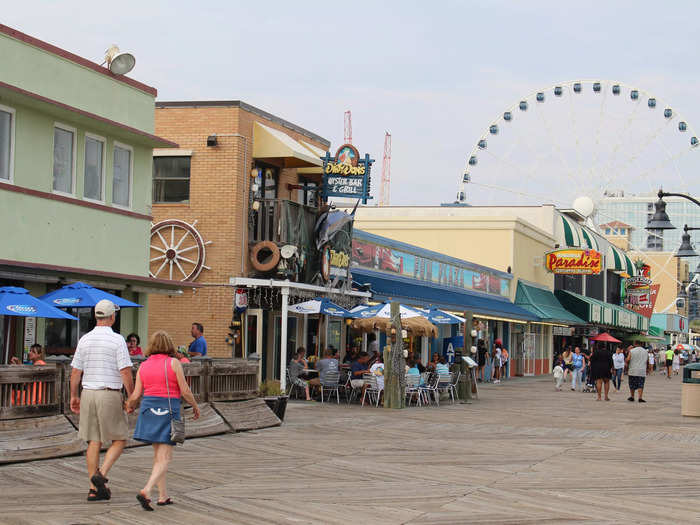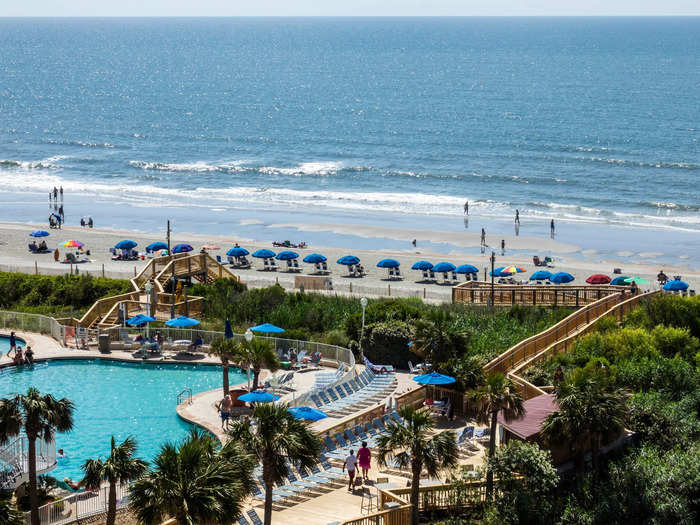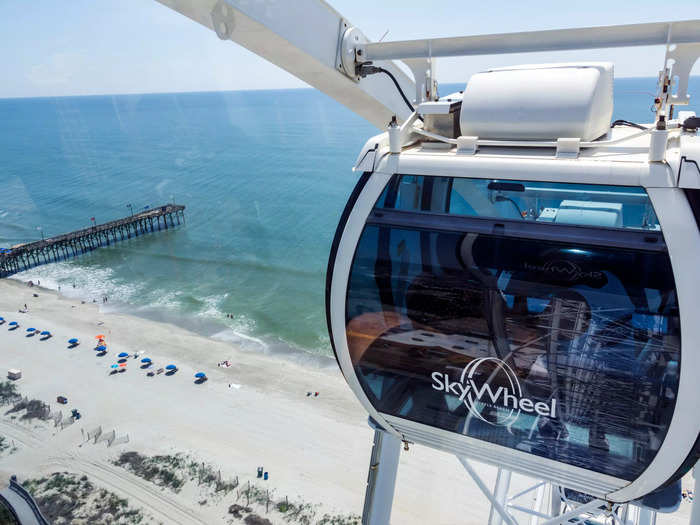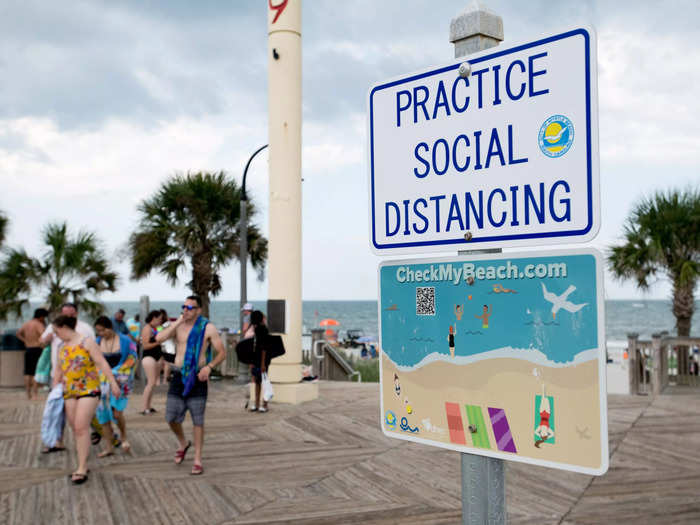John Coletti/Myrtle Beach
- Myrtle Beach is a dynamic, family-oriented, seaside resort.
- There are many hotel, restaurant, and activity options when planning a trip to The Grand Strand.
Myrtle Beach, South Carolina, was historically a modest seaside town with no more than a few charming beachside cottages to mark it as a vacation destination. Those days are long gone, and it has evolved into a dynamic coastal resort, replete with high-rise hotels and condos. The crepe myrtle trees that gave the town its name are still present - if a little eclipsed by the developments - but Myrtle Beach has become one of the region's most popular family resorts.
The town boasts a variety of activities that keep the nation's sunseekers coming back. Beaches and boating are the main stocks-in-trade, with a healthy selection of golf courses also in the mix. The beaches help give the area its nickname, the Grand Strand, the strand in question being some 60 miles of pristine sands from North Myrtle Beach down to Pawleys Island, a silk-smooth stretch that welcomes sunbathing, strolling, and biking. The Grand Strand is much more than the sum of its beaches, though, and Myrtle Beach and the surrounding neighborhoods are ripe for exploring.
Wander around lush, tropical botanical gardens, art galleries that reflect the changing colors of the region, a number of theaters showing family-friendly shows, and shopping that offers everything from high-end designer labels to seaside curios. The Southern culture here is unmistakable, apparent in the pace of life as well as the local cuisine. Menus promise succulent barbecue and some of the freshest seafood you'll find anywhere.
South Carolina has its upscale destination, with Charleston and Hilton Head delivering a sense of refinement. Myrtle Beach, though, is much more democratic, featuring a resort town that caters to a range of budgets with family-oriented attractions. Sit back among the miles of soft sands, while kids build sandcastles around you, in the shadow of the SkyWheel Ferris wheel, and know that life is good here.
Getting to and around Myrtle Beach
Take in the sights on foot along Myrtle Beach's popular boardwalk.
Chicago Tribune/Getty Images
If visitors choose to fly into the region for their Myrtle Beach vacation, there are a couple of options. Charleston and Wilmington, North Carolina, both have fairly close airports, about 100 or 75 miles away respectively. Although services are a little more limited, if it's possible, it makes more sense to fly into Myrtle Beach International Airport itself, which is just 3 miles west of downtown Myrtle Beach.
Most driving routes to Myrtle Beach run via Interstates 95 and 40. These in turn connect to either US Routes 501 or 17, or South Carolina Highways 31 or 22. The main access points through the Grand Strand are US Route 17 Bypass and Kings Highway, also known as US Route 17. In Myrtle Beach, these roads run parallel to the beach.
The city's streets are usually numbered and labeled north or south. Driving or renting a car while in town is handy, if only for exploring the beaches slightly farther down the coast or day trips around the region. It's not the end of the world, though, if you don't want to drive. The main beachfront is very easily navigable on foot, and though it's limiting, there's still plenty to see within walking distance.
A number of bus routes run along the Grand Strand and stop along Ocean Boulevard and Kings Highway. A one-way fare costs $1.50, and unlimited-use day passes are just $5 (see the Coast RTA website for more information).
Taxis and the rideshare apps operate liberally around town, but be sure about your destination, as Myrtle Beach and North Myrtle Beach use different systems for naming and numbering their streets. If you do bring your car, watch the parking meters. It's well worth considering a seven-day visitor's parking pass, available for $30 via the ParkMobile app.
Where to stay in Myrtle Beach
Many resorts in Myrtle Beach include stunning views of the South Carolina coast.
Jeff Greenberg/Getty Images
One thing that you can say with certainty about Myrtle Beach is that there is no shortage of options when it comes to choosing accommodations. The robust development of the past couple of decades has delivered a plethora of options for visitors, from luxe resort hotels to midrange family options, to cute cottages and even well-appointed campsites — if a life of relative simplicity is the vacationing vibe.
Rates tend to be seasonal, with the most expensive time being between mid-June and Labor Day. But Myrtle Beach is becoming a year-round destination, and golfers especially tend to pick up great deals during the quieter patches.
As well as seaside-tinged outposts of major hotel brands, there are some independent standouts. The Moroccan-themed decadence of Anderson Ocean Club & Spa is more memorable than many of its peers, with rich furnishings and opulent design flourishes. The Breakers and The Caravelle Resort are both excellent family options with plenty of activities. Both offer panoramic tower views, chic suites, and lively on-site pools. Grand Shores Ocean Resort is a great value option with fully equipped kitchens in spacious condos.
If the energy of the main drag is a little too much, then retreating to the north end of Myrtle Beach is a great strategy, and oases such as Island Vista Resort are more peaceful, airy, and private. Equally alluring in this market are the 145-acre Kingston Resorts, which have three hotel choices within lush, landscaped grounds.
For selecting cozy cottages and beach houses, it's best to go through an agency such as North Beach Vacations, which has a lovely portfolio of characterful properties. The best of the campsites is Apache Family Campsite and Pier, which has excellent amenities and doesn't allow parties of youngsters to book on their own, so it's tranquil for families.
What to eat in Myrtle Beach
Dagwood's Deli & Sports Bar opened in 1988 and was inspired by Dagwood Bumstead, one of the main characters of the “Blondie” comic strip.
Jeff Greenberg/Getty Images
Although it's a mainstream family resort town, there are several factors at play that make Myrtle Beach a surprisingly attractive prospect when it comes to eating out.
The first is its regional heritage; being located in the American low country means that there's a mix of international traditions mingling with the huge variety of indigenous plants and seafood to create a distinctive cooking style.
The other is economic, and visitors will find that even the more upscale eateries deliver a very impressive value, especially compared to neighbors Hilton Head and Charleston.
African, French, Creole, and Caribbean flavors abound and ingredients such as long-grain rice, seasonal vegetables, and preserves, all of which play a huge part in local menus. Crabs and oysters, figs and peaches, tomatoes, and watermelons are all in abundance in the region and pop up in lots of dishes.
Amid the usual chain restaurants are islands of authenticity such as Sea Captain's House, located in a lovely 1930s oceanfront cottage and specializing in crab cakes and jambalaya. Equally well-loved by locals is Angelo's Steak and Pasta, which has been a fixture here for four decades, due to the quality of its menu and the tableside magic shows. Regional soft-shell crabs are celebrated with no small amount of artistry at Indo Asian Bistro and Sushi Bar, where the owner Laura Smith delights customers with impeccable seafood plates.
Arguably the best low-country menu can be found within the Island Vista Resort, at The Cypress Room. Splurge on their legendary Southern breakfast and order sweet-potato pancakes, or for dinner, try classics such as she-crab soup and crispy fried oysters. The affordable, family-friendly Americana of Jimmy Buffett's and Johnny Rocket's are all present and correct, but for a more idiosyncratic take, head for Dagwood's Deli, named for the newspaper comic character and beloved for its incredible sandwiches.
Activities to explore in Myrtle Beach
The Myrtle Beach SkyWheel takes you up almost 200 feet in the air, with views overlooking the coast.
Jeff Greenberg/Getty Images
Myrtle Beach Boardwalk and Promenade is the main focus of the resort. The boardwalk itself stretches from 14th Avenue Pier to Second Avenue Pier and is the location of several seafood restaurants, old-time arcades, ice cream stands, and souvenir shops. There's also the imposing SkyWheel, a 175-foot Ferris wheel that delivers memorable views and an engaging nighttime light show.
In the summer months, free concerts, firework shows, and carnival rides add to the allure. The public beaches are busy and well appointed with amenities, but for extra space and some of the more scenic spots, head to Cherry Grove, Ocean Drive Beach or Crescent Beach. There are likely fewer crowds on these sands, which are good for fishing, entertainment, and watersports, respectively.
Myrtle Waves Water Park is the largest of its kind in South Carolina and has bodyboarding as well as wave pools and myriad slides, some of which require a tight grasp onto your swimwear. Old-fashioned carnival rides are the order of the day at Pavilion Park, one of the carousels dating back to 1912. For more modern thrill rides, such as the enormous Swamp Fox roller coaster, Family Kingdom is a solid theme park that is much cheaper than Disney.
Adrenaline fixes can also be had riding the Sky Coaster at Broadway Grand Prix Family Race Park, a 26-acre facility with seven types of go-kart racetracks. Golfing and fishing are the biggest sporting pastimes here, and there are over 100 public golf courses, as well as 10 piers for anglers to cast their lines from.
For a change of scenery, the historic town of Conway makes for a great day trip, just 15 miles inland. Conway has become an artistic enclave with studios, galleries, and workshops and has attracted a wealth of talent selling their wares. There's also a growing number of inventive foodie hot spots, such as the Rivertown Bistro.
Local advisories for Myrtle Beach
Pay attention to local advice and general information when traveling to Myrtle Beach.
Sean Rayford/Getty Images
Myrtle Beach is a seasonally busy, family-oriented, seaside resort. Compared to many cities, it's a relatively safe destination, and all visitors should feel secure going about their day-to-day vacation activities.
The main public beaches have a number of attentive lifeguards, sitting atop their towering chairs along the Grand Strand. There are also plenty of notices about how to be as safe as possible around the ocean. Visitors are advised that glass is banned on the beaches, as are fireworks. Swimming is not permitted more than 50 yards from the shore, and though the vast majority of the waters are completely safe, the odd unlucky tourist might get a minor jellyfish sting.
There is a transient element to the population in a tourist destination such as Myrtle Beach. This means that low-level, petty crime can be an issue, with pickpocketing and theft the main dangers to watch out for. Valuables are much better left in the safe in a hotel room than they are in a tote bag on the beach. As with any unfamiliar destination, it pays to keep your wits about you at all times.
There are crowds aplenty on the main drag almost all hours of the day, but take taxis or ride shares between neighborhoods, especially after dark.
Southern hospitality might be something of a cliché, but people in the region are generally friendly and polite. It's a destination that thrives on a strong service industry, and people work hard, especially during the busy seasons. Show locals love where you can, tipping at least 20% in restaurants and bars.
As you explore northward from the boardwalk, you'll find that levels of refinement change subtly, and though North Myrtle Beach isn't quite like Hilton Head or Charleston, it's definitely a quieter, less frantic neighborhood.





